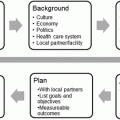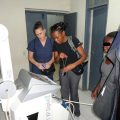Fig. 22.1
Asha Jyoti van arrived at PGIMER, Chandigarh, in April 2012
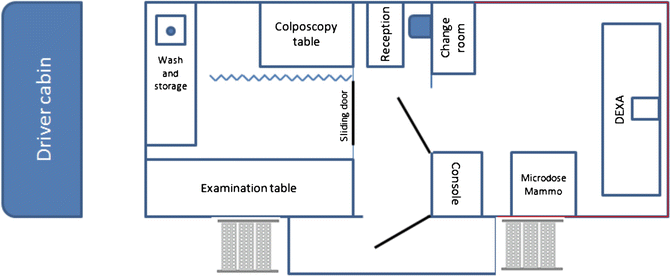
Fig. 22.2
Asha Jyoti van schematic
This mobile health care model relies on three local groups. First is the PGIMER radiologists, technologists, and public health staff who operate the van, implement health awareness training, and survey patients daily for pre- and post-screening experiences. The second group is the multiple subspecialty medical departments at PGIMER that have committed to provide free medical care for women below poverty line (BPL) in accordance with the local government policies. The third group is the local charitable organizations that raise money to fund chemotherapy and medications not covered by the government BPL plan (Figs. 22.3 and 22.4).
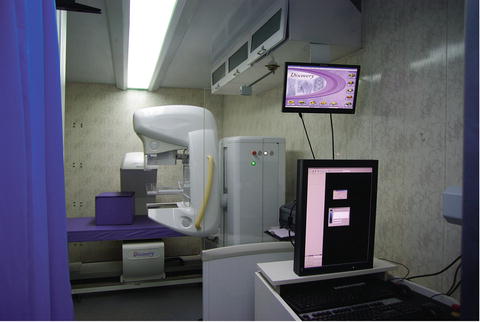
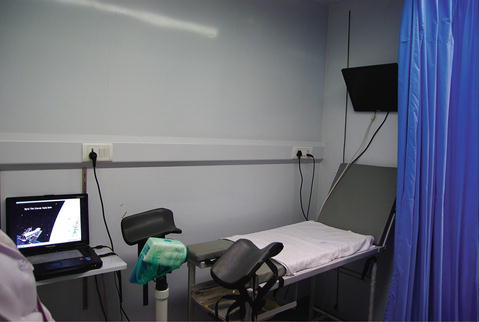

Fig. 22.3
Asha Jyoti imaging room

Fig. 22.4
Asha Jyoti colposcopy room
The goals of the Asha Jyoti program are to increase women’s health awareness, provide a referral system for women into the public hospital system, and diagnose and treat cancers and osteoporosis. Additionally, the program features a breast imaging education exchange between PGIMER and the US clinicians, which encourages collaboration on best practices for imaging and has so far included collaboration between the lead Asha Jyoti radiologists and women’s imaging radiology attendings, fellows, and residents from the top US hospitals, as well as a technologist educational exchange hosted by PGIMER and taught by the US RAD-AID technologist volunteers [88, 89] (Fig. 22.5).
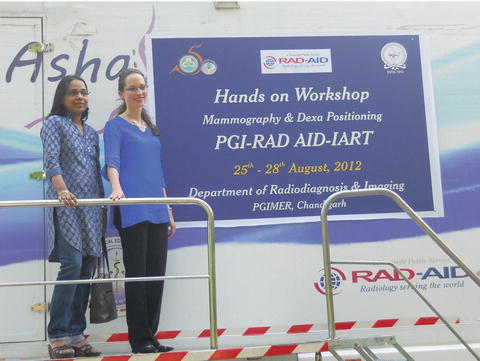

Fig. 22.5
Tulika Singh M.D., Asha Jyoti radiologist (left), and Anna Starikovsky Nordvig, Co-Director of RAD-AID, India (right), at the RAD-AID and PGIMER technologist training workshop in August 2012
In April 2012, RAD-AID and PGIMER began a 6-month pilot program to screen women in Chandigarh and its periphery, including slums, resettlement colonies, and surrounding villages. Asha Jyoti’s goal is to define a model for sustainable integration of mobile health services into a large public hospital system, and the program received substantial governmental and media support upon the pilot launch. Punjabi, Hindi, and English reports in many Chandigarh newspapers as well as attendance of the inauguration by the Minister for Parliamentary Affairs boosted regional awareness of the program. Media reports emphasized the importance of cancer and osteoporosis detection “before the individual shows any signs or symptoms” [90–94].
Prior to the launch, one anticipated hurdle identified from research on previous mobile programs was the lack of public awareness or trust of a screening initiative. However, perhaps due to the strong local media support, patient turnout was strong and utilization of the van screening services was high during the pilot. Furthermore, regional awareness garnered requests from other rural regions for the screening services, allowing Asha Jyoti to test van functionality and outreach efforts in remote rural locations 300–400 km outside of the city. The pilot was created to carefully assess the program’s potential in Chandigarh and rural areas, and based on the initial effectiveness, the program plans to extend to many rural areas of Punjab [95].
Although Asha Jyoti is a local program focusing on locally sustainable growth, lessons from the program launch could impact other mobile screening programs in India and worldwide. In September 2012, the Clinton Global Initiative (CGI) featured Asha Jyoti in the “Champions of Action” plenary session at the CGI 2012 Annual Meeting in New York [96–98].
Outcomes of the Asha Jyoti screening and public awareness are tracked by PGIMER’s Department of Radiodiagnosis and the School of Public Health, respectively, and RAD-AID and PGIMER will meet biannually to assess program results, plan for future growth and improvements, and report translatable findings to the international global health community. Already in 2012, initial lessons from the Asha Jyoti pilot were presented by PGIMER and RAD-AID at the RAD-AID International Conference on International Radiology for Developing Countries, the largest conference on radiology global health in the USA, attended by over 150 radiologists, technologists, nurses, and public health experts and students. In the year following the pilot, Asha Jyoti hopes to expand screening to over 2,000 women, implement a wireless cloud PACS, and develop a “hub and spoke” model for expanding services into regional communities.
Conclusion
Efforts to provide radiological screening services to women in LMICs must be thoughtfully planned and organized to ensure that necessary infrastructure for screening, diagnosis, and treatment is available to the targeted population. The BHGI screening recommendations based on resource levels is a powerful tool for NGOs and governments interested in improving women’s health care in LMICs. Community sensitization, patient education, program data collection, analysis of results, and adequate funding are key components for success. Long-term sustainability of screening programs may be achieved through NGO–government–private partnerships using mobile screening packages, thus allowing the most efficient use of scarce medical resources. RAD-AID implemented many of these key concepts during the development of the Asha Jyoti Women’s Mobile Health Care Program, which may become a template for mobile radiological screening interventions throughout India and in other LMICs.
References
1.
Powell A. Breast cancer danger rising in developing world. 2009. p. 1–2. http://news.harvard.edu/gazette/story/2009/04/breast-cancer-danger-rising-in-developing-world/
2.
3.
Dhillon PK, Yeole BB, Dikshit R, Kurkure AP, Bray F. Trends in breast, ovarian and cervical cancer incidence in Mumbai, India over a 30-year period, 1976-2005: an age-period-cohort analysis. Br J Cancer. 2011;105(5):723–30.PubMedCentralPubMedCrossRef
4.
Leonard M. Old wine in new bottles? Women working inside and outside the household. Womens Stud Int Forum. 2001;24(1):67–78.CrossRef
5.
Fernández R. Culture as learning: the evolution of female labor force participation over a century. National Bureau of Economic Research. 2007.
6.
Chia K-S, Reilly M, Tan C-S, Lee J, Pawitan Y, Adami H-O, et al. Profound changes in breast cancer incidence may reflect changes into a Westernized lifestyle: a comparative population-based study in Singapore and Sweden. Int J Cancer. 2004;113(2):302–6.CrossRef
7.
8.
Parkin DM, Nambooze S, Wabwire-Mangen F, Wabinga HR. Changing cancer incidence in Kampala, Uganda, 1991-2006. Int J Cancer. 2010;126(5):1187–95.PubMed
9.
10.
11.
12.
13.
14.
Canfell K, Banks E, Moa AM, Beral V. Decrease in breast cancer incidence following a rapid fall in use of hormone replacement therapy in Australia. Med J Aust. 2008;188(11):641–4.PubMed
15.
16.
Agarwal G, Ramakant P. Breast cancer care in India: the current scenario and the challenges for the future. Breast Care (Basel). 2008;3(1):21–7.CrossRef
17.
18.
Dhar A. India likely to miss MDG on maternal health. Health. New Delhi: The Hindu; 2012.
19.
Woolf AD, Pfleger B. Burden of major musculoskeletal conditions. Bull World Health Organ. 2003;81(9):646–56.PubMedCentralPubMed
20.
on behalf of the IOF Working Group on Epidemiology and Quality of Life, Kanis JA, Odén A, McCloskey EV, Johansson H, Wahl DA, et al. A systematic review of hip fracture incidence and probability of fracture worldwide. Osteoporos Int. 2012;23(9):2239–56.
21.
Kanis J. WHO scientific group on the assessment of osteoporosis at primary health care level. Brussels; 2007.
22.
Osteoporosis Fact Sheet. International Osteoporosis Foundation. http://www.iofbonehealth.org/ accessed on October 25, 2011
23.
Anderson BO, Distelhorst SR. Guidelines for international breast health and cancer control – Implemenation. CANCER Supplement, 2008;113(8).
24.
25.
Allen TL, Van Groningen BJ, Barksdale DJ, McCarthy R. The breast self-examination controversy: what providers and patients should know. J Nurse Pract. 2010;6(6):444–51.CrossRef
26.
Kosters JP, Gotzsche P. Regular self-examination or clinical examination for early detection of breast cancer. A Cochrane review prepared by The Cochrane Collaboration. Published in the Cochrane Library, 2008, Issue 4.
27.
Shulman LN, Willett W, Sievers A, Knaul FM. Breast cancer in developing countries: opportunities for improved survival. J Oncol. 2010;2010:1–6.CrossRef
Stay updated, free articles. Join our Telegram channel

Full access? Get Clinical Tree



